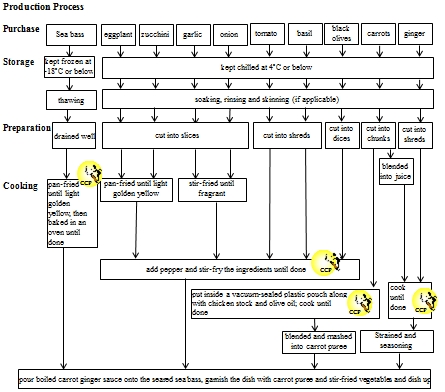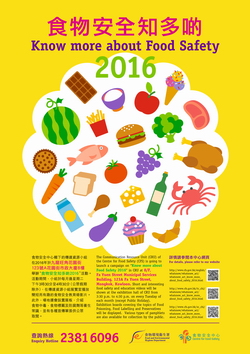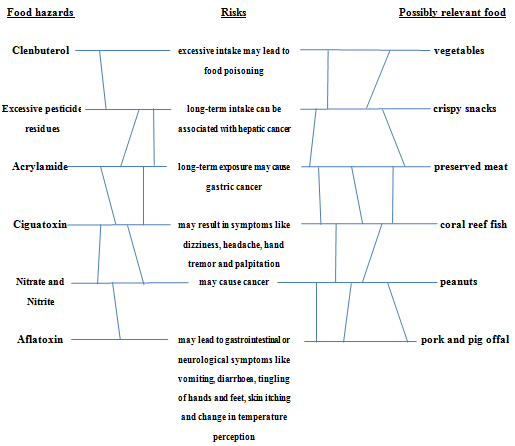
Food Safety Bulletin (1st Issue of 2016)
Feature Article
Import Control of Poultry Eggs
Do you know that the Imported Game, Meat and Poultry Regulations (Cap. 132AK) have been amended? It is now an offence to bring any poultry eggs or eggs into Hong Kong without a health certificate and the written permission of the Food and Environmental Hygiene Department (FEHD).
Purpose of Amending the Regulations
Members of the public should be familiar with avian influenza (AI) as every now and then AI outbreaks make a topic of news reports. AI is caused by influenza viruses that mainly affect birds and poultry, but it may also occasionally infect humans. Clinical presentation of AI in humans includes fever, cough, sore throat, muscle aches, eye infection (conjunctivitis) and severe respiratory infections (e.g. pneumonia). Infection of the more virulent AI A (H5N1, H7N9 or H10N8) viruses can result in respiratory failure, multiple organ failure and even death.
In 2014 and 2015, there were outbreaks of highly pathogenic AI in Europe, the American continents and different parts of Asia. Such outbreaks are expected to occur from time to time. The World Organisation for Animal Health has recommended that an international veterinary certificate should accompany the import of poultry eggs for human consumption for control of AI. The same import requirement has been imposed in many jurisdictions, including the European Union (EU), the United States and Singapore. To further protect Hong Kong from the AI threat, the Government has amended the Imported Game, Meat and Poultry Regulations (Cap. 132AK) to control the import of poultry eggs for protecting public health.

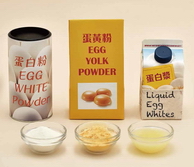
The Amended Regulations
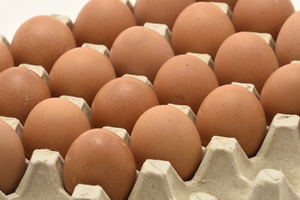
The amended Regulations, known as the Imported Game, Meat, Poultry and Eggs Regulations (Cap. 132AK), have come into operation since 5 December 2015. Any person who imports poultry eggs or eggs into Hong Kong shall:
- produce a health certificate issued by an issuing entity from a place of origin recognised by the Director of Food and Environmental Hygiene to certify that the eggs are fit for human consumption; and
- obtain written permission from a health officer of FEHD after providing relevant information on the import of poultry eggs to FEHD to facilitate tracking of the actual importation and surveillance on the poultry eggs by the Centre for Food Safety (CFS), with a view to safeguarding food safety and public health.
Fully cooked poultry eggs or eggs that constitute one of the ingredients of a compounded food item are excluded from the application of the amended Regulations.
Scope of the Amended Regulations
Under the amended Regulations, "egg" means an egg of a bird belonging to a type of bird sold or offered for sale for human consumption or any edible part of such an egg—
-
whether such an egg or edible part —
- is shelled or unshelled;
- is raw or partially cooked;
- is salted, preserved or otherwise processed;
- is in frozen, liquid or dried form; or
- contains any functional ingredient; but
-
excludes such an egg or edible part that—
- is fully cooked; or
- constitutes one of the ingredients of any compounded food.
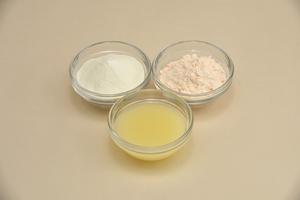
Penalties
The amended Regulations have come into force. Offenders shall be liable on conviction to a maximum fine of $50,000 and imprisonment for six months.
Advice to the Public
As a precaution against AI, the public is advised to observe good personal, food and environmental hygiene at all times. The following are some major points to remember in the handling and consumption of poultry eggs and egg products:
- Wash hands thoroughly with soap or liquid cleanser after handling food.
- Cleanse thoroughly all working surfaces, utensils and equipment that have been used for food handling.
- Wash eggs (with household detergent if required) which are soiled with fowl droppings or stained. Washed eggs should be cooked immediately.
- Avoid consuming eggs with cracked shell as they are prone to contamination.
- Do not use raw or undercooked eggs for preparation of food that will not be cooked further.
- Do not eat raw eggs or dip cooked food into any mixed sauce containing raw eggs. Cook eggs thoroughly until the white and the yolk have become firm.
Readers' Corner
Cyanides and Food Safety
In the past, when "cyanides" were mentioned, what came to mind would probably be poisons appearing frequently in fiction. However, following massive explosions at a hazardous chemical warehouse in Tianjin last year, the public began to have concerns that these chemicals, including cyanides, might pollute air, water and food in the area.
What Are Cyanides?
Hydrogen cyanide (HCN, a colourless gas) and potassium cyanide (a solid) are common examples of cyanides. When HCN is dissolved in water, the solution is known as hydrocyanic acid. Cyanides enter air, water and soil from natural processes (e.g. volcanoes, wildfire and microbiological activities) and industrial activities (e.g. electroplating, gold mining and production of textiles and plastics), but most cyanides in water or soil will evaporate as gaseous HCN. Some cyanides will also be transformed into less toxic chemicals (e.g. carbon dioxide and ammonia) by microorganisms, or form complexes with metals.
Does Food Contain Cyanides?
Cyanide-containing substances occur naturally in over 2 000 plant species, some of these are food plants such as bamboo shoots, cassavas and seeds or stones of apples, apricots, pears, plums, prunes, cherries and peaches. In these plants, cyanides are bound to sugar molecules in the form of cyanogenic glycosides (CGs). CGs themselves are relatively non-toxic, but they will break down to produce toxic HCN in the intestinal tract. Children are more susceptible to cyanide poisoning, which may be caused by chewing only a few seeds of these plants. Cooking cyanogenic plants thoroughly in boiling water can effectively reduce their toxicity.
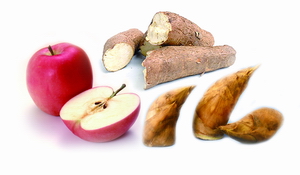
As for animals, cyanides are toxic to them at very low concentrations, and fish is the most cyanide-sensitive group of aquatic organisms reported in the literature. Nonetheless, cyanides in water do not bioaccumulate in living organisms, probably owing to their rapid transformation. The most frequent cause of cyanide poisoning in livestock is ingestion of plants containing CGs. However, according to the European Food Safety Authority, provided the animal is not intoxicated with HCN, the cyanide levels in meat, eggs or milk can be expected to be very low.
What Are Cyanides' Effects on Our Health?
Cyanides are toxic to humans and animals due to their ability to inhibit cell respiration. Acute toxicity in humans is characterised by symptoms such as vomiting, nausea, headache, dizziness, blurred vision, slow heart rate, convulsion and respiratory failure, ultimately leading to death. Symptoms of short-term effects usually occur within minutes after inhalation of cyanides or consumption of cyanide-containing foods.
What Are the Regulatory Control Measures on Cyanides in Foods in Hong Kong?
The Codex Alimentarius Commission (Codex) has established maximum levels of 10mg/kg and 2mg/kg for hydrocyanic acid in cassava flour and gari (an African food made with cassava flour) respectively . In the EU , the maximum permitted levels for hydrocyanic acid are 50 mg/kg in nougat and marzipan, 35 mg/kg in alcoholic beverages and 5 mg/kg in canned stone fruits.
There are no specific legal provisions on cyanide s in food s in Hong Kong. Nevertheless, all foods for sale locally must be fit for human consumption. CFS has been maintaining a close liaison with the relevant authorities in the Mainland and overseas to take appropriate actions in safeguarding public health. The following are examples of regulatory control on cyanides in foods in the international community:
| Maximum Levels / Maximum Permitted Levels of Hydrocyanic Acid in Foods | |
|---|---|
| Codex | Cassava flour : 10 mg/kg |
| Gari (an African food made with cassava flour) : 2 mg/kg | |
| EU | Nougat / Marzipan: 50 mg/kg |
| Alcoholic beverages : 3 5 mg/kg | |
| Canned stone fruits : 5 mg/kg |
Advice to the Public
- Maintain a balanced diet to avoid excessive intake of harmful substances from a small range of foods.
- Handle cyanogenic food plants with care to reduce the risk of poisoning:
- Cut cyanogenic food plants into small pieces and cook them thoroughly in boiling water; and
- Do not eat or chew seeds or stones of apples, apricots, pears, plums, etc.
Readers' Corner
Fats and Oils
Many Hong Kong people feel uneasy hearing about "fats and oils". Fitness lovers are especially averse to greasy food. Actually, fats and oils are an integral part of our diet. They not only supply fatty acids required by the body and provide us with energy, but also enhance cooking by adding distinctive and irreplaceable flavours to food.
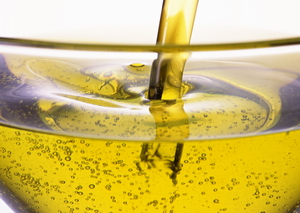
What Are Fats and Oils ?
Fats and oils share a common chemical structure and similar properties. The difference lies in their forms. Generally, fats in liquid form at room temperature are called "oils", whereas those that stay solid are "fats". In terms of chemical structure, each fat or oil molecule consists of three long strings of fatty acid molecules combined with a glycerol molecule.
Fats and oils can be extracted from plants and land or marine animals. Oils are commonly obtained from oil producing plants like corn, peanuts, soya beans, vegetable seeds, olives and palm kernels, while fats are mostly obtained from animal sources like cattle (including milk, butter and tallow) and pigs (including lard). Fats and oils may also originate from marine animals like fish. It should be noted that although butter, margarine and cocoa butter contain fats, they fall outside the scope of fats and oils under the categorisation of Codex, an international food standards and food safety authority, and are therefore regulated by different sets of standards.
Quality Problems
Smart and health-conscious consumers are particularly concerned about the quality and safety of fats and oils. When used for cooking, fats and oils can bring out a unique flavour by adding a golden appearance and a crispy texture to food. However, fats and oils can become rancid with an "off" odour and degrade in quality.
The rate of degradation of fats and oils depends on various factors, such as temperature, light, oxygen and humidity. Storing them in a cool and dry place will help preserve their quality. Alternatively, antioxidants are added to some products to delay the onset of rancidity.
There are various ways to determine the quality of fats and oils. "Acid value (AV)" and "peroxide value (PV)" are two most frequently used quality parameters. AV is a measurement of free fatty acids, including those cleaved from their parent molecule (i.e. triglycerides) by hydrolysis. PV, on the other hand, is an indication of the amount of hydroperoxides (i.e. products of primary oxidation). In general, the lower the AV and PV, the better the quality of fats and oils will be.
Safety Concerns
There has been growing concern over the safety of edible oils in recent years. What substances hazardous to health may be present in fats and oils?
Metallic contaminants
The presence of metallic contaminants (e.g. arsenic and lead) in fats and oils is mostly due to environmental contamination. Prolonged exposure to metallic contaminants can be harmful to the human body. Fortunately, metallic contaminants can be removed in the oil refining process. The levels of such harmful contaminants in properly refined fats and oils available in the market should have been low. Moreover, there is no need to worry about fats and oils in tin cans as they do not experience tin migration.
Erucic acid
Erucic acid is a naturally present fatty acid. It is rich in traditional rapeseed oil (30–60% of the total fatty acids). Tests on experimental animals revealed that excessive intake of erucic acid may damage their heart tissues, but this link has not yet been established in humans. Moreover, canola oil commonly found in the market is made from canola, a variety derived from traditional cross breeding of the rapeseed plant with unwanted traits removed.
Compared with traditional rapeseed oil, canola oil has only low levels of erucic acid (less than 2% of the total fatty acids).
Carcinogenic chemicals
Carcinogenic chemicals that may be present in fats and oils include aflatoxins and benzo(a)pyrene (B[a]P), both classified as human carcinogens (Group 1) by the International Agency for Research on Cancer.
Aflatoxins are highly toxic mycotoxins produced by fungi of the genus Aspergillus , including A. flavus , A. parasiticus and A. nomius . Foods commonly associated with aflatoxin contamination include corn (maize), peanuts (groundnuts), tree nuts and other oilseeds. If these oil-bearing crops are contaminated with aflatoxins, pressing them may result in the presence of aflatoxins in the oil.
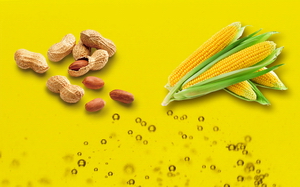
Aflatoxins are nearly completely removed in the oil refinement process. However, proper storage and handling of oil-bearing crops is still important in order to minimise risks, especially for oils which do not undergo any refining process. Oil-bearing crops should be stored in dry places to prevent mould growth.
B[a]P is a kind of polycyclic aromatic hydrocarbons (PAHs) and is ubiquitous in the environment. Apart from environmental contamination, the occurrence of PAHs in oils is mostly related to the drying processes of oilseeds where combustion gases may come into contact with them. Both local and overseas surveillances have shown that certain types of oils (peanut oil, corn oil, grapeseed oil, sunflower oil, olive pomace oil, etc.) may contain higher levels of B[a]P. The Joint FAO/WHO Expert Committee on Food Additives (JECFA) has also concluded that vegetable fats and oils (for the higher concentrations of PAHs in this food group), as well as cereals and cereal products (for their high consumption in the diets of many countries), are the major contributors to dietary intake of PAHs.
In view of the risks to human health from PAHs formed during food processing, Codex has produced a Code of Practice for the Reduction of Contamination of Food with Polycyclic Aromatic Hydrocarbons (PAH) from Smoking and Direct Drying Processes, which specifies that direct contact of oilseeds with combustion products during drying processes should be avoided. In addition, in edible oil refining processes, the use of activated carbon can remove PAHs caused by direct drying and lower the PAH levels to a great extent.
News on New Dishes
Seared Sea Bass with Carrot Puree, Vegetables in French Style and Ginger Carrot Sauce
Many people in Hong Kong prefer a diet with less oil, salt and sugar in pursuit of a healthy lifestyle. While it is easy to manage seasoning usage at our home kitchen, how can we control the amount of oil, salt and sugar used by restaurants when dining out? In fact, no matter we are eating Chinese or Western meals, it is advisable to order more healthy and light dishes. Last time we brought you a Chinese dish "Eggplant Stuffed with Assorted Vegetables and Bean Curd". Let's have something different for a change. In this issue, we have invited Mr WONG Ming-wah, head chef of "La Table" of New World Millennium Hong Kong Hotel, a Food Safety Charter signatory, to demonstrate the preparation of a Western dish "Seared Sea Bass with Carrot Puree, Vegetables in French Style and Ginger Carrot Sauce".
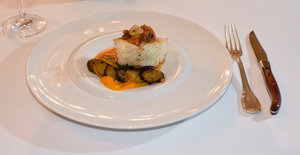
| Preparation Steps | Small Tips, Big Wisdom | |
|---|---|---|
Receiving  |
Purchase ingredients from approved and reliable suppliers. | Upon receipt of the ingredients, check carefully to ensure their freshness. Keep v egetables under refrigeration at 4 ºC or below and frozen seafood at -18 ºC or below . |
Thawing  |
Thaw the sea bass in a refrigerator at 4 ºC or below . | Thawing in a refrigerator at 4 ºC or below not only ensures food safety but also keeps the fresh taste of seafood. |
Rinsing 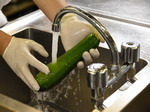 |
Soak and rinse the vegetables thoroughly. | Rinsing vegetables under running water or soaking them in water for an hour can effectively reduce the risk of pesticide intake. |
Cutting  |
Slice the eggplant, zucchini and garlic. Shred the tomato, basil and ginger. Dice the black olives. | Slicing, shredding or dicing the ingredients can shorten the cooking time. |
Searing and Baking 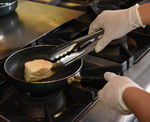 |
Drain the sea bass well. Add a sprinkle of white pepper. Pan-fry the fish over medium heat until both sides turn golden yellow. Bake it at 180 ºC for about 5 minutes until done. | Pre-set the oven to ensure the correct time and temperature for cooking. |
Cooking  |
Put carrots, chicken stock and some butter (or olive oil) into a vacuum-sealed plastic pouch. Keep heated in water at 80ºC. After cooking the ingredients in water for 60 minutes, mash them into carrot puree with a blender. | Preparing the carrot puree by slow cooking prevents evaporative losses of moisture and flavour. This can help retain the moisture and natural flavour of food. |
Pan-frying and Stir-frying 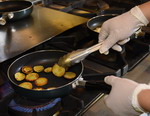 |
Pan-fry the eggplant slices and zucchini slices with olive oil. Stir-fry the garlic slices and onion until fragrant. Mix the ingredients well, then stir-fry them until done. Proper seasoning with pepper. | Pan-fry the vegetables until they turn light golden yellow. This can shorten the time of cooking at a high temperature and prevent the formation of harmful substances during the cooking process. |
Preparing the sauce 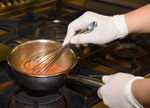 |
Add ginger shreds to carrot juice. Boil the liquid over medium heat until it is reduced to 1/3 of the original volume. Strain the juice. Proper seasoning with olive oil, sea salt and pepper. | Estimate the required amount of sauce in advance to avoid overproduction. |
Saucing 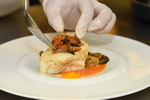 |
Dish up the sea bass. Garnish the dish with carrot puree and stir-fried vegetables. Lastly, pour the ginger carrot sauce onto the fish. Ready to serve. | Bring the sauce to the boil for at least one minute and pour it onto the sea bass. The food should be consumed immediately. |
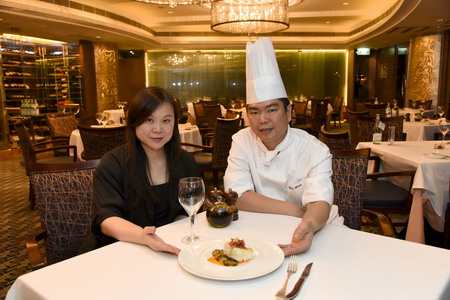
A tasty sea bass dish well prepared by Mr WONG Ming-wah, head chef of "La Table" of New World Millennium Hong Kong Hotel
Tips from Chef WONG
- To observe the dietary principle of "less oil, salt and sugar", we have reduced the amount of oil, salt or sugar used in cooking as far as possible and also used basil and ginger for seasoning. In this way, we can make a healthier dish and preserve the natural flavour of food.
- Olive oil is mainly used for preparing this dish instead of butter. Rich in monounsaturated fats, olive oil is a healthier choice that can bring out the fragrance of food.
- Carrot puree is prepared by means of "sous vide" (slow cooking), which has become popular in recent years. This cooking method helps retain the moisture and natural flavour of food and provides a particularly smooth mouthfeel. By setting the cooking temperature at 80°C, it can assure that the ingredients are thoroughly cooked for making a safe and delicious dish.
Food Safety Plan Corner
Seared Sea Bass with Carrot Puree, Vegetables in French Style and Ginger Carrot Sauce

Ingredients:
Sea bass, eggplant, zucchini, garlic, tomato, basil, onion and black olives
Carrot puree:
Carrots, chicken stock and butter or olive oil
Sauce:
Carrot juice, ginger, olive oil and pepper
Steps:
- Thaw the frozen sea bass in a refrigerator at 4°C or below.
- Take out the vegetables which have been stored at 4°C or below.
- Soak the vegetables in water for an hour and rinse them thoroughly under running water.
- Slice the eggplant, zucchini, garlic and onion. Shred the tomato, basil and ginger. Dice the black olives.
- Drain the sea bass well. Add a sprinkle of white pepper. Pan-fry the fish over medium heat until both sides turn golden yellow. Bake it at 180ºC for about 5 minutes until done.
- Put carrots, chicken stock and some butter (or olive oil) into a vacuum-sealed plastic pouch. Keep heated in water at 80ºC. After cooking the ingredients in water for 60 minutes, mash them into carrot puree with a blender.
- Pan-fry the eggplant slices and zucchini slices with olive oil. Stir-fry the garlic slices and onion until fragrant. Mix the ingredients well, then stir-fry them until done. Proper seasoning with pepper.
- Add ginger shreds to carrot juice. Boil the liquid over medium heat until it is reduced to 1/3 of the original volume. Strain the juice. Proper seasoning with olive oil, sea salt and pepper.
- Dish up the sea bass. Garnish the dish with carrot puree and stir-fried vegetables. Pour the ginger carrot sauce onto the fish. Ready to serve.
Production Process
Critical Control Point (CCP) 
It is a step or procedure in a food manufacture process at which control can be applied and, as a result, a food safety hazard can be prevented or eliminated.
The CCP below should be noted in the production of " Seared Sea Bass with Carrot Puree, Vegetables in French Style and Carrot Ginger Sauce":
- Pre-heat the oven and the sous vide water oven to ensure the correct temperature and time for cooking. All ingredients should be cooked thoroughly before consumption.
Briefing of Activities
The 50th Hong Kong Brands and Products Expo
The Hong Kong Brands and Products Expo (HKBPE) organised by the Chinese Manufacturers' Association of Hong Kong is an annual flagship event in the city and a must-attend occasion for many people. The 50th HKBPE was held at Victoria Park in Causeway Bay between 12 December 2015 and 4 January 2016. Had you dropped by the booth of CFS while purchasing your favourite products in the Expo?
Every year, the CFS booth features a different thematic exhibition with provision of relevant leaflets and pamphlets to visitors. Same as previous years, the exhibition in this year covered a wide variety of topics, including "5 Keys to Food Safety", "Nutrition Labelling" and "Food Safety Advice for Travellers". CFS staff was present to explain the topics and distribute souvenirs to the public. CFS availed itself of this opportunity to disseminate food safety and healthy eating messages to the public by reaching out to them more directly.
The goal of CFS this year is the promotion of "Hong Kong's Action on Salt and Sugar Reduction". It is hoped to encourage the public to develop a healthy eating habit by raising awareness of the importance of reducing dietary salt and sugar intake. In the Expo, video clips were shown and games were held on the performance stage to enable people to learn how to adopt a healthy lifestyle with less salt and sugar through an interactive and game-based approach.
Know more about Food Safety 2016
The Communication Resource Unit (CRU) of CFS at 8/F, Fa Yuen Street Municipal Services Building, 123A Fa Yuen Street, Mong K ok, Kowloon, is organising a series of activities on a regular basis under the campaign "Know more about Food Safety 2016" throughout the year . Education videos on food safety are shown at the exhibition hall of CRU from 3:30 p.m. to 4:30 p.m. on the first and third Tuesdays of each month (except public holidays). Exhibition panels on various food safety and hygiene topics, including nutrition labelling, pesticide and veterinary drug residues and food safety plans are displayed. Various kinds of leaflets and posters are also available for collection by the public.
Food Safety Q&A
Is It Safe to Eat Insects?
When people talk about entomophagy (the consumption of insects), they may just think of TV scenes of exotic customs or novel foods from different parts of the world. While insect eating is rare in Hong Kong, there have been media reports about candies and ice cream made with insects available in the market. Have you ever considered this unconventional food challenge or contemplated on the safety of insect food products?
Human societies have a long history of utilising insects as food, a practice which is common in many places around the world, notably in Asia, Africa and Latin America. Insects can provide us with protein and other nutrients. In quite a number of places, insects have also formed part of traditional medicine for thousands of years.
According to the Food and Agriculture Organization (FAO) of the United Nations, out of an estimated six to ten million species of insects in the world, 1900 are documented in literature as edible, including beetles, caterpillars, bees, wasps and ants. As food, insects can be eaten whole or ground into powder or paste, and incorporated into other foods.
FAO considers that exploring the feasibility of mass insect rearing and promoting insects as food can help solve the food safety problem caused by world population growth. There are many potential environmental and social benefits of eating insects. Compared with conventional livestock farming, insect farming is less land-dependent. Moreover, apart from providing protein and other nutrients, insects have high feed-conversion efficiency (i.e. an animal's capacity to convert feed mass into increased body mass) and can thus enhance efficiency in food production.
As insects are not commonly consumed as food all over the world, some people will inevitably have concerns about the safety of eating insects. In respect of food safety, FAO is of the view that there are no known cases of transmission of diseases or parasites to humans resulting from the consumption of insects (on the condition that the insects are handled under the same sanitary conditions as any other food). Nevertheless, like ordinary food animals, insects may be infected with pathogenic microorganisms. Proper measures (e.g. thorough cooking) should be taken in the processing and storage of insects and their products to ensure food safety.
Evidence of allergies induced by ingestion of insects (though rather scarce) does exist. It should also be noted that some insects may have toxic parts. Additional treatment (e.g. removal of toxic parts) is required before such insects can be served as food.
We should clearly understand the nature of a new food and its potential risks before trying it, just in the same way we do with any traditional food. Consumers should also ensure that all foods are purchased from reliable retailers. By maintaining a balanced and varied diet, we can minimise the health risks resulted from consuming a small range of food.
Truth against Fallacy
Is there any difference between the values "0 g per serving" and "0.0 g per serving" as expressed in the nutrition label?
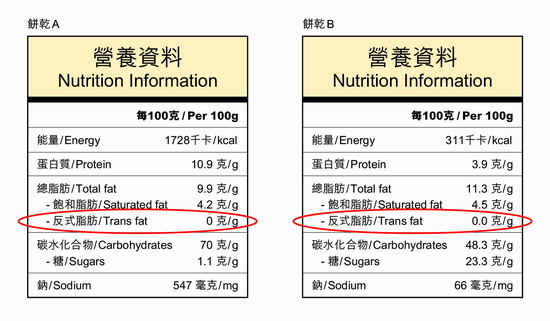
| Ming: | There are not enough snacks and drinks at home. What should we buy this time? Just talking about biscuits, there are already so many varieties. How to choose? |
| Pat: | Remember the CFS seminar we attended last time? There was a part on reading the nutrition label. The keynote speaker reminded us to choose foods low in sodium and sugars, too. |
| Ming: | Certainly! Other than less salt and sugar s , we should also choose foods low in total fat, saturated fat and trans fat. This can help us maintain a healthy heart and the desirable body weight. |
| Pat: | ...How about this biscuit product? The nutrition label says it contains 0 g of trans fat per serving. It should be healthy enough. |
| Ming: | Hey, my choice is not much different from yours. It has 0.0 g of trans fat per serving. 0 and 0.0... any actual difference? |
| Pat: |
0 and 0.0 are different. If the value "0 g per serving" is expressed in the nutrition label, it would be considered that the nutrient concerned is absent in the product, or is present in such a small amount that the value has been rounded off to "0" according to the definition of "0" stated in the Technical Guidance Notes on Nutrition Labelling and Nutrition Claims. For example, according to the Technical Guidance Notes, to declare the value "0 g of trans fat per serving" on a product, each 100 g of the product should contain no more than 0.3 g of trans fat. On the other hand, if the testing method can measure the nutrient content more accurately, the value "0.0 g per serving" would be considered to have been rounded off to the nearest 0.1 g. For instance, to declare the value "0.0 g of trans fat per serving" on a product, the product should contain less than 0.05 g of trans fat per serving; if it contains more than 0.05 g, the value should be rounded up to 0.1 g. |
| Ming: | Got it! Anyway, these two biscuit products are both very low in trans fat, right? |
| Pat: | Yes. If you want to learn more about nutrition labelling, you can visit CFS' dedicated website at www.nutritionlabel.gov.hk . There you can find advice to consumers and the food trade as well as other practical information. |
Brain Gym
Matching
A food hazard is any substance or factor that may cause the food to be unsafe for human consumption. It can be identified as a biological, chemical or physical hazard. Below are some chemical hazards of concern and their related risks. How many of them do you know?
Answers
| Food hazards | Risks | Possibly relevant food |
|---|---|---|
| Clenbuterol | may result in symptoms like dizziness, headache, hand tremor and palpitation | pork and pig offal |
| Excessive pesticide residues | excessive intake may lead to food poisoning | vegetables |
| Acrylamide | may cause cancer | crispy snacks |
| Ciguatoxin | may lead to gastrointestinal or neurological symptoms like vomiting, diarrhoea, tingling of hands and feet, skin itching and change in temperature perception | coral reef fish |
| Nitrate and Nitrite | long-term exposure may cause gastric cancer | preserved meat |
| Aflatoxin | long-term intake can be associated with hepatic cancer | peanuts |
Enquiries and Subscription
Printed copies of the Food Safety Bulletin can be obtained from the Communication Resource Unit at 8/F., Fa Yuen Street Municipal Services Building, 123A Fa Yuen Street, Mong Kok, Kowloon. For enquiries, please call 2381 6096. The public may also visit the CFS website (www.cfs.gov.hk) for the online version.
| Enquiry hotline | 2868 0000 |
|---|---|
| E-mail address | enquiries@fehd.gov.hk |
| CFS website | www.cfs.gov.hk |
